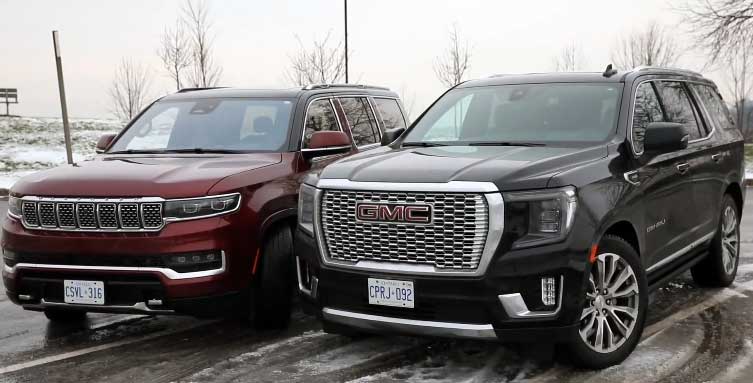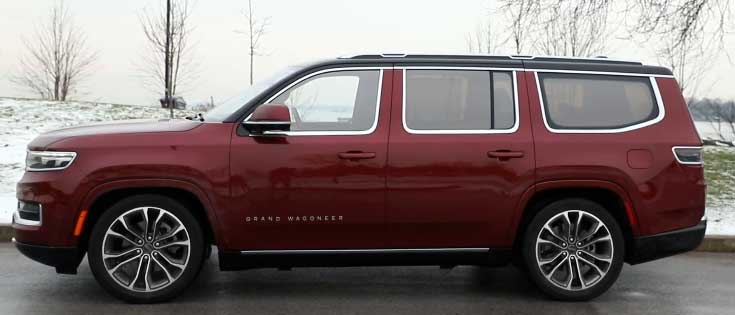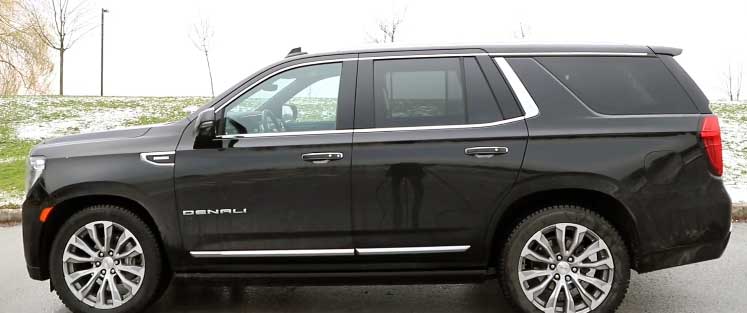I’ve always been drawn to big SUVs—the kind that command the road, haul families with ease, and tackle adventures without breaking a sweat. When it came time to choose between the 2025 Jeep Wagoneer and the 2025 GMC Yukon, I knew I had a tough decision ahead. Both are titans in the full-size SUV world, blending luxury, capability, and presence.
In this article, I’ll walk you through their strengths, weaknesses, and key features to help you decide which one fits your life best. Let’s get started with a side-by-side comparison.

Comparison Table: Jeep Wagoneer vs. GMC Yukon
| Feature | Jeep Wagoneer (2025) | GMC Yukon (2025) |
| Starting MSRP | $62,945 | $69,395 |
| Fuel Economy (City/Hwy) | 17/24 MPG | 16/20 MPG |
| Cargo Space (Behind 3rd Row) | 27.4 cu.ft. | 25.5 cu.ft. |
| Max Cargo Space | 122.8 cu.ft. | 122.9 cu.ft. |
| Front Legroom | 40.9 in | 44.5 in |
| Second-Row Legroom | 42.7 in | 42.0 in |
| Engine Options | 3.0L Twin-Turbo Inline-6 (420 hp) | 5.3L V8 (355 hp), 6.2L V8 (420 hp), 3.0L Diesel (277 hp) |
| Towing Capacity | Up to 10,000 lbs | Up to 8,400 lbs |
| Infotainment Screen | 10.1-inch standard, multiple screen options | 16.8-inch standard |
| Key Features | Adaptive cruise control, leather upholstery, optional air suspension | Google Built-In infotainment, power-sliding console, diesel option |
| User Rating (TrueCar) | 4.6/5 | 4.85/5 |
Why I’m Comparing These Two SUVs
As someone who’s driven everything from compact crossovers to hulking trucks, I’ve learned that full-size SUVs like the Jeep Wagoneer and GMC Yukon are in a league of their own. They’re built for families who need space, adventurers who crave capability, and drivers who want a touch of luxury without sacrificing utility. But choosing between them isn’t just about picking the flashiest ride—it’s about finding the one that aligns with your priorities, whether that’s towing, tech, or fuel efficiency.
I’ve spent time researching, test-driving, and digging into user reviews to break down what makes each SUV shine and where they fall short.
Jeep Wagoneer: A Modern Take on Jeep’s Legacy
When I first laid eyes on the 2025 Jeep Wagoneer, its seven-slot grille and boxy stance screamed Jeep heritage, but with a polished, modern twist. It’s not just a rugged off-roader; it’s a luxury SUV that competes with the best. The Wagoneer starts at $62,945, which is a steal compared to the Yukon’s $69,395 base price.
That lower entry point makes it appealing if you’re looking to save a few bucks without skimping on features.

Pros of the Jeep Wagoneer
- Better Fuel Economy: The Wagoneer’s 17 MPG city and 24 MPG highway edges out the Yukon’s gas-powered models (16/20 MPG for the 5.3L V8). If you cringe at frequent gas station stops, this is a win. It uses mid-grade gas, which is easier on the wallet than the Yukon’s premium-requiring 6.2L V8.
- More Cargo Space: With 27.4 cubic feet behind the third row, the Wagoneer beats the Yukon’s 25.5 cubic feet. This makes it easier to toss in strollers, sports gear, or groceries without folding seats. Max cargo space is nearly identical at 122.8 cu.ft.
- Superior Towing Capacity: The Wagoneer can haul up to 10,000 pounds, outpacing the Yukon’s max of 8,400 pounds. It’s ideal for towing boats or campers. The optional air suspension smooths out the ride and makes towing feel effortless.
- Luxurious Interior: Standard leather upholstery, heated and cooled front seats, and a 10.1-inch infotainment touchscreen give it a premium feel. Optional passenger-side and rear entertainment screens add a tech-savvy edge. Second-row sunscreens are great for keeping kids comfortable on sunny drives.
Cons of the Jeep Wagoneer
- Touch-Sensitive Controls: The reliance on touch controls for seat heaters and other functions is frustrating. It takes too many taps to adjust settings, which can be distracting while driving. User reviews note similar annoyances with glitchy infotainment.
- Reliability Concerns: Some owners report electrical issues and trim pieces falling off, especially in early models. The Wagoneer uses a proven RAM 1500 frame, but its reliability is less established than the Yukon’s. Reddit users mention teething problems, though major breakdowns are rare.
- Cramped Front Legroom: The Wagoneer’s 40.9 inches of front legroom feels tight compared to the Yukon’s 44.5 inches. Taller drivers may feel cramped. This is noticeable during long drives.
- Lower Resale Value: The Wagoneer’s resale value is below average for the segment. GMC’s SUVs, like the Yukon, tend to hold their value better. This matters if you plan to sell or trade in later.
GMC Yukon: The Tried-and-True Contender
The 2025 GMC Yukon pulls up with a bold, chrome-heavy grille and a commanding presence that’s hard to miss. It’s been a staple for families and adventurers for decades, and the latest model builds on that legacy with refined tech and versatile powertrains. Starting at $69,395, it’s pricier than the Wagoneer, but it brings a lot to the table.

Pros of the GMC Yukon
- Versatile Engine Options: The Yukon offers a 5.3L V8 (355 hp), 6.2L V8 (420 hp), or 3.0L diesel (277 hp). The diesel’s 21 MPG city and 27 MPG highway are stellar for a full-size SUV. It’s a game-changer for long commutes or road trips.
- Spacious and Intuitive Interior: The 16.8-inch touchscreen with Google Built-In is bright and user-friendly. Physical buttons for climate and seat controls are a relief compared to the Wagoneer’s touch-heavy setup. The Denali trim’s wood accents and plush leather feel like a luxury lounge.
- Generous Front Legroom: With 44.5 inches of front legroom, the Yukon is a haven for taller drivers. The power-sliding center console is handy for stashing gear. Underfloor storage adds smart organization options.
- Proven Reliability: GM’s full-size SUVs have a solid track record for durability. While some users report transmission issues, the Yukon’s long-term dependability is a strong suit compared to the Wagoneer’s spotty reports. Reddit reviews often praise its longevity.
Cons of the GMC Yukon
- Poor Gas Engine Efficiency: The Yukon’s 5.3L V8 gets 16/20 MPG (city/highway), lagging behind the Wagoneer. Without the diesel, you’ll hit the gas station more often. The 6.2L V8 requires premium gas, adding to costs.
- Less Cargo Space: The Yukon’s 25.5 cubic feet behind the third row is slightly smaller than the Wagoneer’s 27.4 cubic feet. This can be a pain for daily hauls with all seats up. Max cargo space is nearly identical at 122.9 cu.ft.
- Lower Towing Capacity: The Yukon’s max towing of 8,400 pounds is solid but doesn’t match the Wagoneer’s 10,000 pounds. Heavy trailers may push its limits. This is a drawback for serious haulers.
- Higher Starting Price: At $69,395, the Yukon is nearly $7,000 more than the Wagoneer. Top-tier Denali trims approach $90,000, which feels steep for similar luxury. You’re paying for the GMC badge and reliability.
Driving Experience: How They Feel on the Road
Behind the wheel, the Wagoneer and Yukon offer distinct vibes. The Wagoneer’s optional air suspension makes it feel like you’re gliding, even on rough roads. Its 420-hp twin-turbo engine delivers quick acceleration—0-60 mph in 5.3 seconds, per Car and Driver.
But the touch-heavy controls and occasional tech glitches can pull you out of the moment. The Yukon feels more planted and predictable. Its diesel engine is quiet, and the 10-speed transmission shifts smoothly.
The ride is firm but comfortable, though it lacks the Wagoneer’s air-suspension plushness. I found the Yukon’s handling cumbersome in tight spaces, but on the highway, it’s a smooth cruiser. The Denali’s adaptive dampers add refinement, but they’re not standard on lower trims.
Technology and Infotainment: A Tale of Two Systems
Tech is a big deal in modern SUVs, and both deliver, but in different ways. The Wagoneer’s Uconnect system is sleek, with a 10.1-inch touchscreen that’s sharp and responsive. Higher trims offer a passenger-side touchscreen and rear entertainment screens, great for keeping everyone entertained.
But the system’s complexity can be a headache—Apple CarPlay issues and glitchy heads-up displays are common complaints. The Yukon’s 16.8-inch touchscreen is a showstopper. It’s bright, intuitive, and integrates Google Maps and voice assistants seamlessly.
I loved how easy it was to navigate menus, and the optional 15-inch heads-up display projects clear, readable info. Lower trims like the SLE feel less modern, with fewer tech bells and whistles.
Safety and Driver Assistance: Neck and Neck
Both SUVs come loaded with safety tech. The Wagoneer includes standard adaptive cruise control, lane-keeping assist, and pedestrian detection. The Yukon matches these and adds blind-spot monitoring and a surround-view camera on higher trims.
Both have solid crash-test ratings from the NHTSA and IIHS, so you can’t go wrong here. My only gripe is the Wagoneer’s touchy lane-keeping system, which felt overly aggressive on curvy roads.
Off-Road Capability: Jeep’s Heritage vs. Yukon’s Grit
Jeep’s DNA gives the Wagoneer an edge off-road. Its available four-wheel-drive systems and air suspension make it a beast on trails, though most owners will stick to pavement. The Yukon’s AT4 trim is built for off-roading, with skid plates and all-terrain tires, but it’s not as nimble as the Wagoneer in rough terrain.
If you’re planning backcountry adventures, the Wagoneer feels more capable, but the Yukon holds its own.
Also Read: Jeep Liberty vs. Jeep Patriot
Which SUV Suits Your Lifestyle?
Choosing between the Wagoneer and Yukon comes down to what you value most. If you want a lower starting price, better fuel economy, and superior towing, the Wagoneer is tough to beat. Its modern design and tech-heavy interior appeal to families who want a touch of luxury without breaking the bank.
But if reliability, a spacious front row, and a diesel option are your priorities, the Yukon’s proven platform and intuitive tech make it a strong contender. I leaned toward the Yukon for its polished interior and long-term dependability, but the Wagoneer’s towing prowess and extra cargo space kept me second-guessing. Your choice depends on whether you’re chasing Jeep’s bold style or GMC’s refined reliability.
Frequently Asked Questions (FAQ)
The Wagoneer is slightly larger, measuring 214.7 inches long and 83.6 inches wide compared to the Yukon’s 210.0 inches long and 81.0 inches wide. However, the Yukon XL is longer at 225.2 inches.
Jeep isn’t discontinuing the Wagoneer as of 2025. It’s a key part of their lineup, with strong sales and updates for the new model year.
The Chevrolet Suburban offers more cargo space (41.5 cu.ft. behind the third row) and a lower starting price ($61,600) than the Wagoneer. However, the Wagoneer has better towing (10,000 lbs vs. 8,300 lbs) and a more modern interior. Choose the Suburban for space, the Wagoneer for luxury and towing.
Reliability Concerns: Electrical issues and trim quality problems reported.
Cramped Front Legroom: Only 40.9 inches, less than the Yukon.
Touch-Sensitive Controls: Frustrating to use while driving.
Lower Resale Value: Below average compared to GM SUVs.
Conclusion: Your Road, Your Choice
You’re standing at a crossroads, deciding between the 2025 Jeep Wagoneer and GMC Yukon. I’ve laid out the pros, cons, and key features to help you navigate this choice. The Wagoneer offers value, towing muscle, and a tech-forward cabin, but its reliability and ergonomics need work.
The Yukon counters with a refined interior, versatile engines, and a stellar track record, though its price and handling have drawbacks. Test-drive both, think about your needs—family trips, towing, or off-roading—and pick the SUV that feels like home. What’s your next move?

